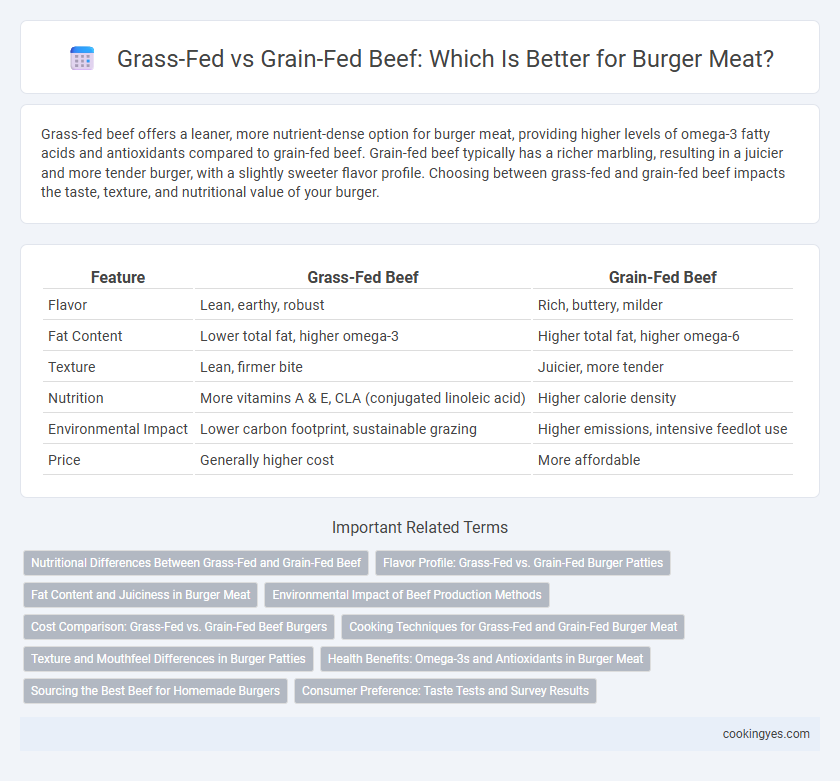Grass-fed beef offers a leaner, more nutrient-dense option for burger meat, providing higher levels of omega-3 fatty acids and antioxidants compared to grain-fed beef. Grain-fed beef typically has a richer marbling, resulting in a juicier and more tender burger, with a slightly sweeter flavor profile. Choosing between grass-fed and grain-fed beef impacts the taste, texture, and nutritional value of your burger.
Table of Comparison
| Feature | Grass-Fed Beef | Grain-Fed Beef |
|---|---|---|
| Flavor | Lean, earthy, robust | Rich, buttery, milder |
| Fat Content | Lower total fat, higher omega-3 | Higher total fat, higher omega-6 |
| Texture | Lean, firmer bite | Juicier, more tender |
| Nutrition | More vitamins A & E, CLA (conjugated linoleic acid) | Higher calorie density |
| Environmental Impact | Lower carbon footprint, sustainable grazing | Higher emissions, intensive feedlot use |
| Price | Generally higher cost | More affordable |
Nutritional Differences Between Grass-Fed and Grain-Fed Beef
Grass-fed beef typically contains higher levels of omega-3 fatty acids, conjugated linoleic acid (CLA), and antioxidants such as vitamin E compared to grain-fed beef. Grain-fed beef often has more total fat, including saturated fat, which affects its calorie content and flavor profile. The difference in fatty acid composition influences the nutritional value of burgers, with grass-fed options providing a leaner, potentially heart-healthier choice.
Flavor Profile: Grass-Fed vs. Grain-Fed Burger Patties
Grass-fed beef burger patties deliver a robust, earthy flavor with a slightly gamey and grassy undertone, appealing to those seeking a more natural and complex taste. Grain-fed beef burger patties offer a richer, buttery flavor with higher marbling, resulting in a juicier and more tender texture. The choice between grass-fed and grain-fed beef significantly influences the burger's overall flavor profile and mouthfeel, catering to different consumer preferences.
Fat Content and Juiciness in Burger Meat
Grass-fed beef typically contains less total fat but higher levels of healthy omega-3 fatty acids, contributing to a leaner burger with a distinct, robust flavor. Grain-fed beef has more marbling, which enhances fat content and improves juiciness, creating a tender and flavorful burger experience. The balance between fat content and juiciness in burgers depends on the feeding regimen, where grain-fed beef offers richer moisture retention, while grass-fed beef delivers a leaner, nutrient-dense option.
Environmental Impact of Beef Production Methods
Grass-fed beef production typically results in lower greenhouse gas emissions due to natural grazing practices that promote carbon sequestration in pasture soils. Grain-fed beef requires intensive feed crop cultivation, often involving significant fertilizer use, contributing to higher nitrous oxide emissions and greater water consumption. Choosing grass-fed beef supports more sustainable land use and reduces the overall environmental footprint of burger meat production.
Cost Comparison: Grass-Fed vs. Grain-Fed Beef Burgers
Grass-fed beef burgers generally cost more than grain-fed beef due to higher production expenses associated with raising cattle on pasture. Grain-fed beef benefits from faster growth rates and lower feed costs, resulting in more affordable burger options for consumers. The price difference reflects the distinct feeding practices and their impact on supply chain efficiency.
Cooking Techniques for Grass-Fed and Grain-Fed Burger Meat
Grass-fed beef burgers require lower cooking temperatures and shorter cooking times to prevent over-drying due to their leaner fat content, while grain-fed beef benefits from higher heat to render the marbled fat, enhancing juiciness and flavor. Resting the patty after cooking allows juices to redistribute, which is crucial for both types but especially important for grass-fed beef to maintain tenderness. Using gentle flipping techniques preserves the structure of grass-fed burgers, whereas grain-fed patties tolerate more aggressive handling due to their higher fat content.
Texture and Mouthfeel Differences in Burger Patties
Grass-fed beef burger patties offer a leaner texture with a firmer bite and a slightly coarser grind, creating a chewier mouthfeel that emphasizes natural beef flavors. Grain-fed beef patties tend to be juicier and more tender due to higher fat marbling, resulting in a smoother, richer mouthfeel and a buttery, melt-in-your-mouth experience. The contrast in fat content directly influences the burger's succulence and chewiness, making texture and mouthfeel key factors in choosing between grass-fed and grain-fed beef for burgers.
Health Benefits: Omega-3s and Antioxidants in Burger Meat
Grass-fed beef used in burger meat contains higher levels of omega-3 fatty acids and antioxidants such as vitamin E and glutathione compared to grain-fed beef, promoting heart health and reducing inflammation. The superior nutrient profile in grass-fed burgers supports better cardiovascular function and enhanced immune response due to increased conjugated linoleic acid (CLA) content. Choosing grass-fed beef for burgers delivers a healthier balance of essential fatty acids and bioactive compounds linked to improved metabolic health.
Sourcing the Best Beef for Homemade Burgers
Grass-fed beef for burgers offers a distinct flavor profile, rich in omega-3 fatty acids and antioxidants, sourced from cattle grazing on natural pastures. Grain-fed beef provides a more consistent marbling and tenderness, resulting from a controlled diet primarily of corn and soy, enhancing juiciness and flavor. Choosing the best beef depends on preference for nutritional benefits or texture, with grass-fed appealing to health-conscious consumers and grain-fed favored for classic burger taste.
Consumer Preference: Taste Tests and Survey Results
Grass-fed beef burgers often attract consumers seeking a leaner, more robust flavor profile, while grain-fed beef tends to offer a richer, buttery taste preferred by a broad audience in taste tests. Surveys reveal a growing segment values grass-fed options for perceived health benefits and ethical considerations, influencing purchasing decisions despite a slightly stronger, sometimes gamey flavor. Grain-fed beef remains dominant in consumer preference due to its consistent tenderness and juiciness, critical factors in burger satisfaction.
Grass-fed beef vs Grain-fed beef for burger meat Infographic

 cookingyes.com
cookingyes.com